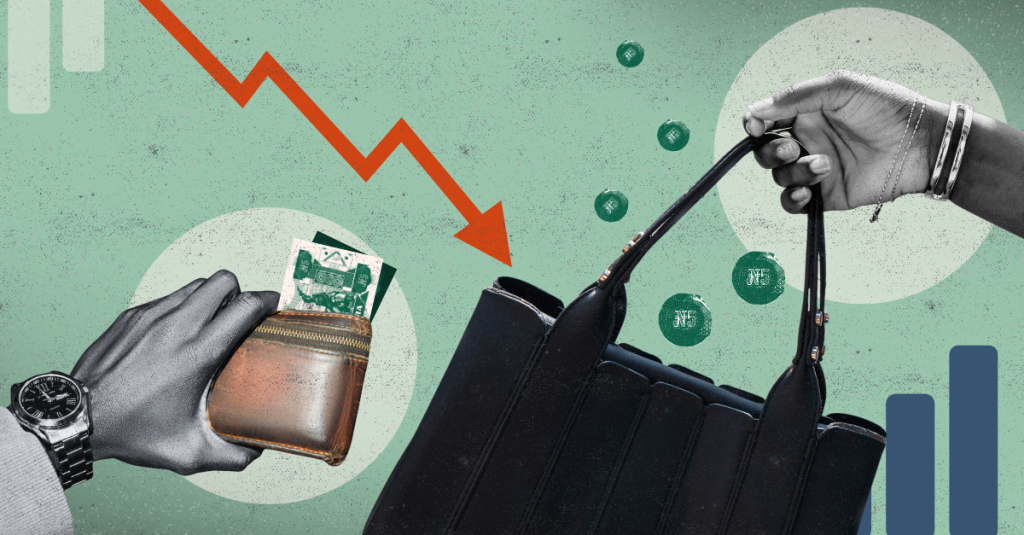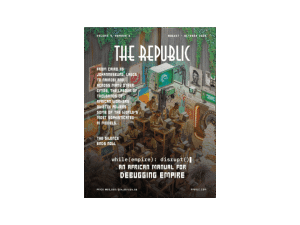
Photo Illustration by Ezinne Osueke / THE REPUBLIC. Source Ref: Unsplash.
THE MINISTRY OF GENDER X SEXUALITY
How Nigerian Loan Providers Marginalize Women

Photo Illustration by Ezinne Osueke / THE REPUBLIC. Source Ref: Unsplash.
THE MINISTRY OF GENDER X SEXUALITY
How Nigerian Loan Providers Marginalize Women
In a 2004 paper, Ugandan academic and activist, Silvia Tamale, aptly described the nature of gender disparity in access to resources. According to Tamale, ‘women’s access to resources is like their access to political fora, severely curtailed, thus calling into question the notion that women are full citizens.’
In March 2025, the ratio of male to female applicants for the Nigerian Education Loan Fund (NELFUND) student loans was 4:1 in favour of male students. This gap is stark: while male students outnumber female students in some tertiary institutions, the ratio is approximately 1.25:1. For instance, according to the National Bureau of Statistics, in the 2020/2021 academic session, female students accounted for 44.49 per cent of total enrolments in Nigerian universities. As an initiative of the federal government of Nigeria, NELFUND was established to provide interest-free loans and skill development opportunities to students in Nigerian tertiary institutions. According to its mandate, the primary benefits of this credit facility are to reduce the financial burden on students and their families and to promote equal access to higher education for all eligible candidates.
Even as a lecturer, I had been unaware of the details of the NELFUND application process, though I occasionally came across a little information about the scheme online. More recently, I took the opportunity to have a proper conversation with a university lecturer, who had been tasked with overseeing applications and disbursements. When I asked him what he thought accounted for the gender disparity, he burst into a deep belly laugh. ‘You women,’ he said, ‘you’re scared of debt. However, the guys somehow believe they can get away without ever repaying what they borrow.’ His response, though flippant, echoes findings in behavioural studies. In 2022, researchers, Caroline Perrin and Laurent Weill, found that women tend to be more risk-averse, while men are generally overly confident about borrowing but less reliable about repayment.
Still, I knew that the reasons women are held back from accessing credit were far more complex than just a fear of debt. It is important to emphasize that access to credit isn’t a challenge limited to student loans. As of 2024, only about six per cent of Nigerian women had access to any form of credit facility. In the micro, small and medium enterprises (MSME) sector, for example, it was estimated that the credit access disparity favouring men exceeds $158 billion. Thus, it is imperative to truly unpack the extent to which access to credit has been unequal and to examine the drivers and effects of this disparity. Only through this can there be a targeted approach that accommodates women’s economic needs and access to finance.
EXAMINING THE POSSIBLE DRIVERS OF GENDER DISPARITY
A key question is: what drives the disparity in access to credit between men and women? For many rural women—though not directly in the case of NELFUND applicants—lack of access to collateral remains a major barrier. Take land rights, for instance. Due to entrenched patriarchal traditions, women are often excluded from land ownership or control, placing them at a disadvantage in securing loans. In 2018, public administration expert, Adeoye Akinola, pointed to the deep structural inequalities that define land access across many parts of Nigeria. These inequalities, rooted in customary practices, have effectively pushed women to the economic margins. Beyond collateral, many women express anxiety about future job security, raising concerns about how they might repay loans. These fears are often linked to reduced financial autonomy, stemming from the caregiving responsibilities women disproportionately shoulder. For instance, women usually bear the burden of supporting children, the elderly and other dependents within the family structure. Researchers, Lucia Dunn and Ida Mirzaie, have justified this fear that women have about borrowing, by establishing that women experience 30 per cent more stress than men as result of financial debt.
Another likely reason for the low rate of loan applications among female students is a growing lack of trust in the disbursement process itself. In trying to understand the nature of this distrust, I had a conversation with a female student who did not apply for the loan. Precious Ojonugwa Sunday, a 300-level student of Prince Abubakar Audu University, Nigeria, remarked: ‘I do not trust government institutions and I am sceptical about receiving funds from them for this reason.’ The assertion from Sunday aligns with current happenings. In April 2025, NELFUND issued a press statement suggesting that some institutions were failing to refund tuition fees to students, even after receiving funds from the loan scheme on the students’ behalf. Such irregularities further discourage women from participating in the initiative.
shop the republic
THE LIKELY CONSEQUENCES OF UNEQUAL ACCESS TO CREDIT
In the long run, this disparity in credit access is likely to widen existing economic inequalities, with disproportionately severe consequences for women. I foresee the butterfly effect unfolding among many female students. Despite their strong academic performance (indeed, at the university where I teach, female students increasingly dominate the top of the GPA tables), they risk graduating into a world where they accumulate less savings, fewer investments and fewer assets than their male peers. Even more troubling, they may earn lower salaries, despite outperforming male students academically.
The vocational skill training and interest-free components of the NELFUND scheme should make it particularly attractive. Yet, bypassing these components may leave women at a long-term disadvantage. Male students, if they continue to access these types of loans more frequently, are poised to enter the workforce better skilled and less financially constrained. In fact, this imbalance may become an advantage for them. In economies like Nigeria, where high systemic inflation is a persistent feature, debt can sometimes work in favour of the borrower, particularly when the repayment period is extended. Over time, the real value of the money repaid may be significantly less than the value of the money originally borrowed, effectively reducing the borrower’s repayment burden.
Another serious consequence of unequal access to credit is the heightened risk of financial abuse. In societies where women lack financial autonomy, intimate partner financial abuse is more likely to persist. In addition, female students, who are already vulnerable due to caregiving burdens may be less resilient to income shocks, such as the sudden death of a parent. This could trigger higher dropout rates among female students. This is a challenge that could lead to more financial isolation in future for these students. It is necessary to note that not all outcomes are distant or hypothetical. Some are immediate. For example, increased financial vulnerability can expose female students to exploitation, often manifested through the harmful and high-risk university aristo culture, where economic desperation leads some young women into transactional relationships. Aristo culture powerfully illustrates what happens when financial need meets a lack of institutional safeguards, especially for women.
shop the republic
WHY MORE WOMEN NEED GREATER ACCESS TO CREDIT
There are compelling reasons to expand credit access for female students. Research, such as the 2022 Perrin and Weill study, consistently shows that women are more creditworthy than men. Female borrowers are statistically more likely to repay loans than their male counterparts, who are currently the predominant beneficiaries. As American feminist, Gloria Steinem, once remarked, this kind of imbalance reflects ‘mediocrity that was rewarded because it was born into a male body.’ Simply put, it is both logical and strategic to make credit more accessible to the more responsible borrowing group. Improving women’s access to loans would therefore enhance the long-term sustainability of initiatives like NELFUND.
One of the most immediate benefits of improved access to credit is enhanced financial security, which is a fundamental pillar of student well-being and academic success. In the conversation I had with Sunday, I sought to understand which aspects of her daily life would most benefit from additional funds through NELFUND. Two key areas stood out: food and housing security. She shared her desire to regain weight she had lost due to inadequate access to larger and healthier portions of food. Sunday also described the challenges of living in an overcrowded but cheaper accommodation, where constant distractions hindered her ability to study effectively. Her experience illustrates how limited financial resources can directly compromise a student’s wellbeing and academic performance.
shop the republic
-
‘The Empire Hacks Back’ by Olalekan Jeyifous by Olalekan Jeyifous
₦70,000.00 – ₦75,000.00Price range: ₦70,000.00 through ₦75,000.00 This product has multiple variants. The options may be chosen on the product page -
‘Make the World Burn Again’ by Edel Rodriguez by Edel Rodriguez
₦70,000.00 – ₦75,000.00Price range: ₦70,000.00 through ₦75,000.00 This product has multiple variants. The options may be chosen on the product page -
‘Nigerian Theatre’ Print by Shalom Ojo
₦150,000.00 -
‘Natural Synthesis’ Print by Diana Ejaita
₦70,000.00 – ₦75,000.00Price range: ₦70,000.00 through ₦75,000.00 This product has multiple variants. The options may be chosen on the product page
shop the republic
THE PATHWAYS TOWARDS EQUITABLE ACCESS
Reforming the landscape of credit access is the logical next step toward ensuring the long-term sustainability of initiatives like NELFUND. Policies must be designed to attract, support and retain female borrowers, beginning with the younger generation. One of the most effective ways to build early trust is by establishing robust and inclusive financial frameworks that respond to women’s realities. Broadly, expanding credit access would require a twofold strategy. First, making it easier to enrol and secondly, simplifying repayment processes. In parallel, I believe that closing the gender gap in asset ownership is critical. Many future borrowers—even those with stable incomes—may need to rely on the sale of personal or family-owned assets, especially those that have appreciated in value, to repay loans. Without assets to leverage, many women will remain excluded from the credit system, perpetuating cycles of economic vulnerability.
In addition, certain labour policy reforms must be taken more seriously than ever. For example, if the younger generation of borrowers can observe consistent and upward reviews of the national minimum wage, they may feel more secure that their future residual income will not be significantly depleted during loan repayment. Improving working conditions through equitable wage reforms will not only support faster repayment but also increase confidence among risk-averse female borrowers, thereby encouraging greater participation in credit schemes.
Beyond strengthening the integrity of the scheme itself, greater emphasis must be placed on increasing public awareness. I spoke with another student from the same institution and department as Sunday, Hassana Eleojo Sanni, who admitted she was unaware that the loan was interest-free. This is a clear indication that more robust publicity efforts are needed. To further enhance the scheme’s impact, NELFUND, in collaboration with tertiary institutions, should consider introducing performance-based incentives. For example, students who graduate with first-class degrees could be eligible for a discounted repayment structure. If a student owes ₦500,000, a ten per cent reduction could serve as both a reward and motivation. Since private-sector employers often prioritize candidates with higher GPAs, this strategy aligns with the likelihood that top-performing female students would enter the job market sooner and begin to see a return on their educational investment.
Finally, it is important to ensure that female beneficiaries of the scheme are not exploited by those closest to them, including parents or intimate partners. One proactive step could be to assign a financial counsellor at each university, tasked with enhancing financial literacy and responsible resource management among student beneficiaries. This would not only support female students but also increase the overall efficacy and sustainability of the loan program.
One question I grappled with throughout this work and only began to find clarity on much later, is the nature of risk aversion. Is the fear of risk inherently a bad thing? Not necessarily. A study carried out by Neil Stewart, a professor of behavioural science, suggests that female investors, though generally more risk-averse, are less likely to suffer capital losses. Take Sanni, for instance. Although she found the interest-free component of the NELFUND loan appealing, she still expressed a desire to graduate on a clean slate, without any financial obligations. Her perspective reflects the caution many women feel about debt, even when the terms are favourable.
Yet, feminist author, Naomi Wolf, encourages women to embrace informed risk. She advocates boldly: ‘Ask for money in your lives. Expect it. Own it. Learn to use it.’ Her call to action reframes financial risk not as something to fear, but as something to understand and navigate strategically.
In retrospect, expanding women’s access to credit may require revisiting pre-colonial African traditions, which were deliberately dismantled by colonial administrations that imposed patriarchal European systems, marginalizing women from financial decision-making and risk-taking. Traditional African societies provide ample evidence that women were not passive economic actors but strategic risk-takers. For example, Igbo women were renowned for running complex trade networks. Delayed payment agreements were made especially during difficult harvests or when the buyer was low on cash. Many female traders would take goods on credit and travel long distances to sell them in order to repay their debts, demonstrating a sophisticated form of financial risk-taking and trust-based borrowing. This is an example of early models of financial innovation and risk-sharing mechanisms that predate modern banking. They show that risk aversion, when rooted in wisdom and structure, can be both strategic and empowering for women⎈
BUY THE MAGAZINE AND/OR THE COVER
-
‘Make the World Burn Again’ by Edel Rodriguez by Edel Rodriguez
₦70,000.00 – ₦75,000.00Price range: ₦70,000.00 through ₦75,000.00 This product has multiple variants. The options may be chosen on the product page -
The Republic V9, N2 Who Dey Fear Donald Trump? / Africa In The Era Of Multipolarity
₦40,000.00
















